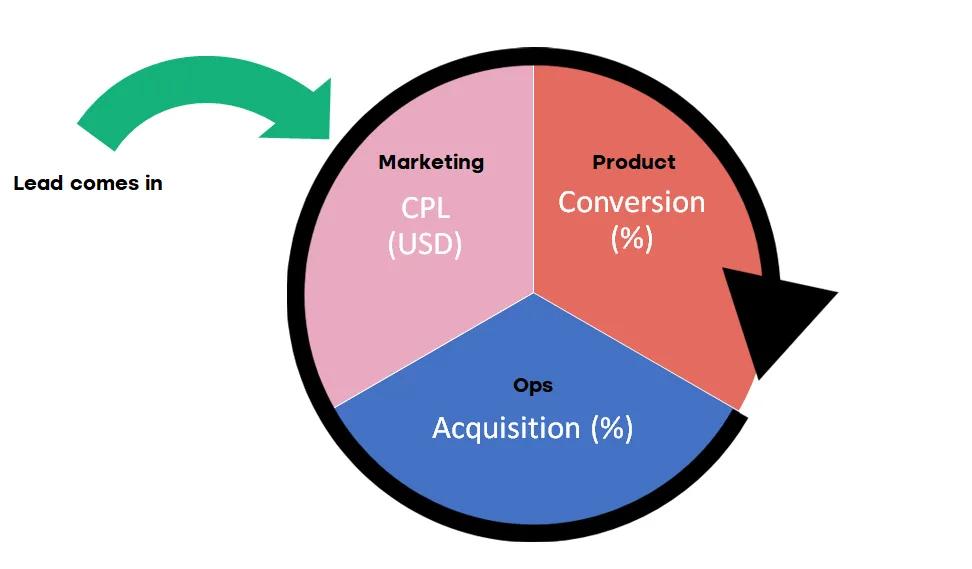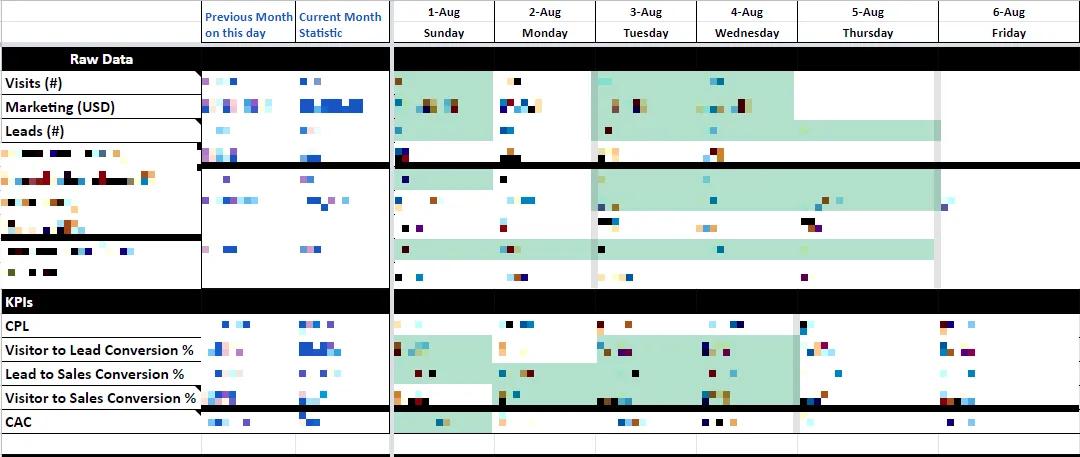Overcoming KPI debt
August 9, 2021

Although I knew what the acronym KPI stood for in 2018, I couldn’t understand what my company’s KPIs were at the time no matter how much I researched the topic. I later attributed it to the fact that our team was still building solutions looking for problems. In other words, we didn’t have clear KPIs because our product itself lacked clarity.
Today we know exactly what our product is - we’re building a full stack insurance company from scratch. At the management level, we’ve decided to set a singular goal internally for each 12 month cycle. Once that was sorted, each department was informed of this single ✌ “north star” ✌, and we worked together to see if its feasible or not. We then broke down that goal into singular department specific goals, and it’s helped us escape what I’d like to call KPI debt. The post you’re reading will focus on what’s worked for our startup as we geared for series A. Specifically, I'll talk about:
Prioritization vs perfection
Setting a single north star, which all KPIs merge into
Why we only have one KPI per team
Prioritization vs perfection
The term KPI debt came up in a conversation with one of our advisors, who explained to me that our lack of product prioritization at the time resulted in certain departmental KPIs simply becoming unattainable by team members, not matter how hard they would have worked in isolation. This could happen to any startup that is restricted by resources (both human and capital).
To explain what I mean, I’ve come up with a couple of imaginary scenarios below a where KPI debt became an issue. I’ve italicized the relevant KPIs for reference:
EXAMPLE 1:
A startup focused on providing customers with bank loans was restricted by a small marketing budget and considered reducing their costs per lead.
They decided that a good way would be to improve their search engine optimization (SEO), so their website hits the Google Search front page, which in turn leads to a lower cost per click (as the customers would click a searched URL instead of an ad). After a lengthy back and forth between the marketing and tech team on optimizing loading time for landing pages, the tech team realized they were overwhelmed and had no choice but to delay a sprint in automating the company’s CRM. This in turn led to more pressure on the ops/sales team taking a longer time to convert leads to sales because they have more manual inputs that could have otherwise been digitized.
Realize that there are only so many calls a salesperson can do per day without CRM optimization and VOIP integration, no matter how hard they work. In this example, narrow thinking with diminishing returns led the startup to optimize their SEO at the serious cost of lead conversion, a KPI which matters significantly more at that early stage to their core requirement: get sales and grow fast.
EXAMPLE 2:
A food delivery startup decided to offer extreme discounts by carving them out of their delivery commissions. This was done to deflate their customer acquisition costs on a short term basis, dubbing it a strategic loss. While their customer acquisition cost dropped during this month-long campaign, what they didn’t realize is that this led to a serious KPI debt in customer retention which would only become obvious in the long run.
If the only differentiator in your product over other delivery apps is price, then these customers will ditch you the moment you can no longer sustain your so-called “strategic loss”. I call this the Zomato dilemma.
Aggressive marketing strategies focused solely on price naturally stray your team away from customer-centricity and instead towards the cheapest lead they can buy. Typically, these leads are purely driven by price, and most likely will never be loyal to your brand, regardless of your customer support and UI/UX improvements.
Although I’ve used a food delivery app in this example, it applies even doubly so for B2C annual subscriptions (such as insurance policies). If you focus exclusively on the cheapest third party liability policies you can sell, then do not expect to maintain a low churn at renewal.
From reading the above, you can see that KPI debt results from the combination of miscommunication, obsessive perfectionism, and poor prioritization of tasks to reach your north star.
The Hala north star
There are so many business books, seminars, articles and videos outlining the difference between your Key Performance Indicators (KPIs) and Objectives and Key Results (OKRs) and MBOs (I forgot what this one stands for) and Balanced Scorecards (BSC). The ABC list is endless and the fight between each management method’s proponents looks somewhat like this:

Focusing so much on performance benchmarks leads to vanity metrics that don’t actually improve your startup. Instead of all these acronyms, our team opted for a straight forward term: the Hala north star. We needed one specific metric we can achieve in 12 months. This was one number that the entire company needs to think about every time they switch on their computer. We decided on the following north star for hala:
we need to sell <number redacted> policies in the next year.
From there, everything else becomes clear. To make a dent in the market, we need to sell <number redacted> car and home insurance policies by August 2022.
The tasks became clear to each department. At the end of each day, the teams ask themselves:
- Marketing: What’s your cost per lead?
- Product: What’s your conversion rate?
- Sales: How many policies have you sold today?
This in turn, leads me to my last point…
Stick to one KPI per team
If each department has one main KPI to reach your north star of <X> sales, then accountability is straight forward. Let’s imagine a B2C startup scenario where a lead1 costs 10 USD via Google Search. Assuming this B2C startup has three departments, the KPI wheel should look like this:
Marketing: the team needs to hustle at any cost to retain a CPL of X or below. They’ll need to know what their exact cost per lead is every day. If the cost goes up over a two day period, that’s OK. If it keeps going up for longer than a few days, they need to investigate what changed. If absolutely NOTHING from the marketing side changed, then…
Product: the product team needs to identify and communicate with the marketing team why leads aren’t converting (%) despite the marketing strategy not changing. Is there a certain broken link on the landing page? Is there something wrong along the customer journey? Can we change the layout of some buttons or shuffle the steps of the customer journey?

The above KPI wheel allows us to isolate a specific reason why a certain KPI is up or down instead of shooting in the dark. Let’s now assume that the CPL (marketing) is fantastically low, and that the conversion % is at an all-time high, but leads are still not converting to customers, then…
Ops: Is the sales team communicating fast enough with the customer, or are we losing them to competitors? Is feedback from leads that the price is too high? Is the payment gateway link broken? Are customers complaining about the product not being as advertised?
When experimenting with new ideas (whether its new ad campaigns or A/B testing landing pages), there is nothing more important than being able to benchmark your results against past performances. How else will you be able to identify why something worked or didn’t work.
Isolating and noting down any change to the KPI wheel daily means you’re constantly fine-tuning as you go, and is the perfect way to stay diligent and avoid KPI debt.
Fine tuning
While the benefits of plain language goals are hard to argue with, the purpose of this post isn’t to debate the number of KPIs your team has to have, but rather to show which ones should be prioritized. Below a sample sheet that tracks each team’s most important KPIs, along with raw data that supports these KPIs. The raw data is what you “improve”, and the KPIs are the result.

Your north star KPIs may differ based on your startup’s industry, and your mileage may vary with the results. If you face resistance when imposing these KPIs on your departments, make sure you hear out why they think these KPIs are not a good fit for them. If not done properly, creating a solid template for plain-language metrics simply ends up becoming a colorful way to consumes time, tie up resources, and create resentment without any benefit.
Having a north star you can fixate on takes courage and commitment. You may slip up and miss goals every now and then, but in the end it’s worth the effort.